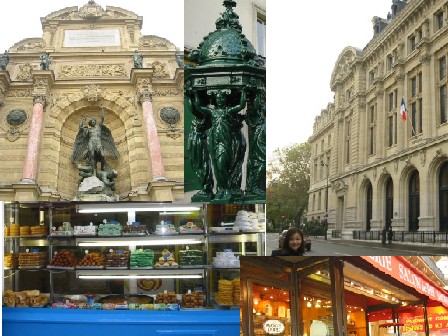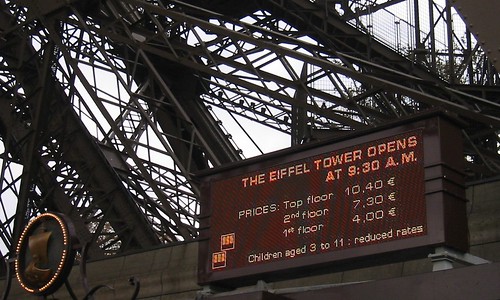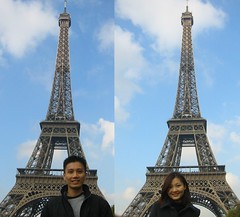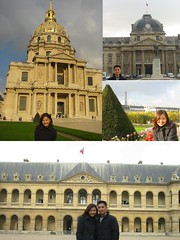PARIS Day02//09.Nov.04 - An Eiffel & Eyeful of Paris: Latin Quarter + Invalides + St. Germain-Des-Pres
Our second day in Paris started with a walk in one of Paris' liveliest area - the Latin Quarter. S and I arrived at Metro St. Michel and were instantly greeted by a statue of St. Michael slaying a dragon. From Place St. Michel, we diligently followed the suggested route that had us walking along the cafe-lined Boulevard St. Michel, which turns off into Rue des Ecoles, hence passing by the Sorbonne University^ and finally into an area known as Little Athens. Everything here was typically Greek. From the angular lettering found above Greek restaurants to the bright blue paint and Greek delicacies displayed.From the name itself, the Latin Quarter gave me a first impression of being an ancient and scholarly neighbourhood, which in a sense, it is. It has some of Paris' oldest buildings, churches, and academic institutions. However, having seen crowds of youngsters heading for class and going about with their morning errands, I find the Latin Quarter an interesting melange* of the old and young. The studious nature of the Latin Quarter is imbued with a youthful exuberance imparted by its mainly young-ish residents. It's striking how the spirit of a place is not just characterized by its history and architecture, but also its inhabitants.**
I got the above definition from Merriam-Webster. How very apt, I thought. The Eiffel Tower is indeed quite an eyeful. And it works both ways. At 115m (2nd level) it provided us with a panaromic view of the city beneath us. So am I done with "eyeful"? Not quite yet. I did say very apt. Most of us are aware of the masculine/feminine gender usage in the French language. Monuments are generally refered in the masculine voice i.e. le***. However, the French with loving pride refers to the Eiffel as La Tour Eiffel because they see the tower as the embodiment of exquisite beauty.Main Entry: eye·ful
Pronunciation: 'I-"ful
Function: noun1 : a full or completely satisfying view 2 : one that is visually attractive; especially : a strikingly beautiful woman
Lady Luck (or could it be Lady Eiffel?) smiled on us that day and rewarded us the perfect weather when S and I took our individual shots with the Eiffel. With the stately structure and bright blue sky behind us, the pictures came out great despite it being a previously grey morning. We happily walk down Champ-de-Mars^^, which is the garden that stretches from the Eiffel to Ecole Militaire. Ecole Militaire is France's Royal Military academy where Napoleon was once a cadet. From there, we continued marching towards the Invalides, where we spent some time scouting the grounds of Hotel Des Invalides (war veteran hospital) and Musee de l'Armee (war museum). Within that compound, aside from the occassional war relics (e.g. canons) there was a soldiers' chapel, St. Louis-des-Invalides, which we entered. We however did not enter the more impressive golden Dome Church that held Napoleon's Tomb.
All that marching left us hungry and we proceeded to a popular restaurant that was recommended by a friend in the lively Rue Cler market area. S ordered a salade caesar, while I had the salade chevre at Cafe du Marche. The star of my salad was the square block of soft creamy cheese wrapped in crispy crepe on a bed of very fresh (the restaurant is in the middle of a market!) vegetables. The bed of vegetables was arranged in 4 different quadrants of variety. At one corner, couscous,^^^ the other coleslaw and there were helpings of french (but of course!) beans and an assortment of other vegetables. After being rewarded with a smile by the tall and attractive African-descent waitress for my "L'addition s'il vous plaît",**** we continued feasting with our eyes on the display of fromage (cheese) and fruits found at the food market.
With our appetites taken care of, it was time for art and we headed to Musee d'Orsay,^^^^ where I got to appreciate the actual impressionist paintings that I would normally only see in books. I was especially thrilled to see the familiar and famous paintings from Monet, Van Gogh, and Manet.
After trawling the expanse of the Musee d'Orsay, S and I capped our evening by exploring the gentrified neighbourhood of St. Germain-des-Pres. Here, S and I strolled past numerous cafes, a night market and speciality pâtisserie shops with displays beckoning shoppers with colourful macarons (macaroons), gâteaux (cakes) and tartes (tarts). With that, our second day ended deliciously***** on a sweet note!
^ The Latin Quarter is home to several important French universities, perhaps the best known being the Sorbonne, the first university founded in France (1257) and one of Europe's oldest as well. The students from this university lend much of the youthful character for which the Latin Quarter is renowned. The university was the source of considerable original activity in French basic research by such personalities as Marie Curie and Louis Pasteur. - http://www.franceway.com/w3/Travel/paris/Sightseeing/monuments/sorbonne.htm
^^ Originally a parade ground for the officer cadets of the Ecole Militaire. The area has since been used for horse-racing, balloon ascents and mass celebrations for 14 July, the anniversary of the Revolution. - DK Eyewitness
^^^ Pronounced, KOOS-koos. Couscous is associated with Morocco, but is a staple of the North African cuisine. Couscous is granular semolina (cracked wheat) which can be cooked and served as a porridge, as a type of salad (similar to pasta salad), or served with various fruits. Couscous varies from country to country, Moroccans tend to include saffron, Algerians like to add tomatoes and Tunisians spice theirs up with the hot pepper based harissa sauce. - www.spike-jamie.com/library/terms.html
^^^^Architects created one of the world's great museums from an old rail station, the neoclassical Gare d'Orsay, across the Seine from the Louvre and the Tuileries. The Orsay boasts an astounding collection devoted to the watershed years 1848 to 1914, with a treasure trove by the big names plus all the lesser-known groups (the symbolists, pointillists, nabis, realists, and late Romantics). The 80 galleries also include Belle Epoque furniture, photographs, objets d'art, and architectural models. - Frommer's
* I simply have to point out my serendipitous choice of word in this context - Pronunciation: mA-'länzh, -'länj Etymology: French, from Middle French, from mesler, meler to mix. - Merriam-Webster
** Some people may shake their heads at my personification of a place/neighbourhood/city/country. It may be outlandish to some, but it's something that I can't help doing after getting acquainted with a piece of land and all its social, cultural, political and economical baggage.
*** Go to http://babel.altavista.com/, type "the monument" in the 'Translate a block of text' field and select 'English to French'. The result returned will be "le monument".
**** the bill please
***** Etymology: Middle English, from Middle French 1 : affording great pleasure : DELIGHTFUL








1 Comments:
where's day 3! eagerly anticipating the next installment in your paris diary :)
tc
Post a Comment
<< Home